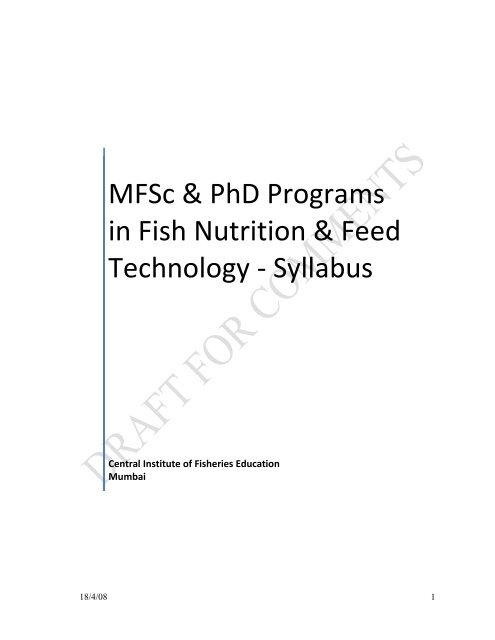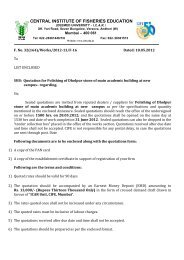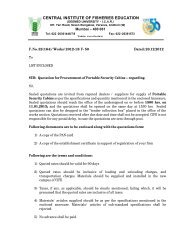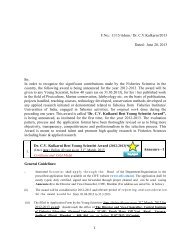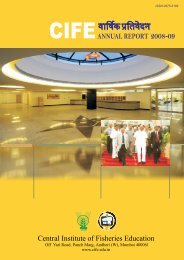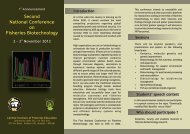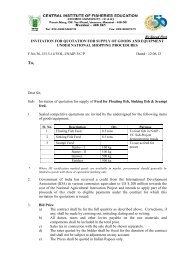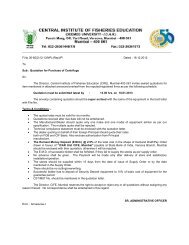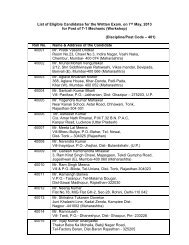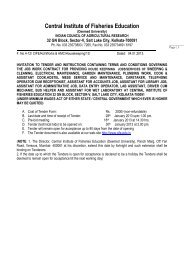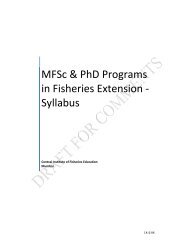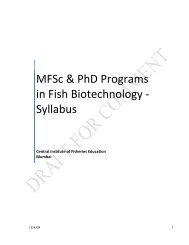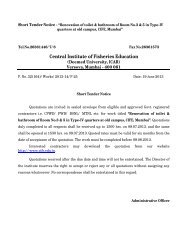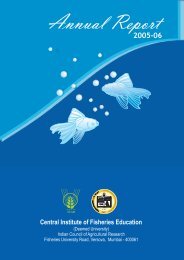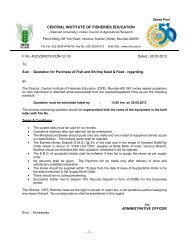Fish Nutrition & Feed Technology MFSc & PhD Syllabus
Fish Nutrition & Feed Technology MFSc & PhD Syllabus
Fish Nutrition & Feed Technology MFSc & PhD Syllabus
Create successful ePaper yourself
Turn your PDF publications into a flip-book with our unique Google optimized e-Paper software.
<strong>MFSc</strong> & <strong>PhD</strong> Programs<br />
in <strong>Fish</strong> <strong>Nutrition</strong> & <strong>Feed</strong><br />
<strong>Technology</strong> - <strong>Syllabus</strong><br />
Central Institute of <strong>Fish</strong>eries Education<br />
Mumbai<br />
18/4/08 1
M.F.Sc (<strong>Fish</strong> <strong>Nutrition</strong> and <strong>Feed</strong> <strong>Technology</strong>) Major Courses<br />
Code Course Title Credits<br />
CORE COURSES<br />
1. FNB 501 <strong>Fish</strong> <strong>Nutrition</strong> 2+1<br />
2. FNB 502 <strong>Nutrition</strong>al Biochemistry 2+1<br />
3. FNB 503 <strong>Feed</strong> Formulation and <strong>Feed</strong> <strong>Technology</strong> 2+1<br />
4. FNB 504 <strong>Nutrition</strong>al Energetic 2+1<br />
OPTIONAL COURSES<br />
1. FNB 505 Digestive physiology 1+1<br />
2. FNB 506 Vitamins and Minerals <strong>Nutrition</strong> 1+1<br />
3. FNB 507 <strong>Nutrition</strong>al Requirements and <strong>Feed</strong>ing Management 1+1<br />
4. FNB 508 Protein <strong>Nutrition</strong> 1+1<br />
5. FNB 509 <strong>Feed</strong> Ingredients and Additives 1+1<br />
6. FNB 510 <strong>Nutrition</strong> and <strong>Feed</strong>ing of Crustaceans 1+1<br />
7. FNB 511 Lipid <strong>Nutrition</strong> 1+1<br />
8. FNB 512 Carbohydrate <strong>Nutrition</strong> 1+1<br />
<strong>PhD</strong> (<strong>Fish</strong> <strong>Nutrition</strong> and <strong>Feed</strong> <strong>Technology</strong>) Major Courses<br />
Code Course Title Credits<br />
CORE COURSES<br />
1. FNB 601 Advances in Bioenergetics 2+1<br />
2. FNB 602 Advances in <strong>Feed</strong> <strong>Technology</strong> 2+1<br />
3. FNB 603 Larval and Brood Stock <strong>Nutrition</strong> 2+1<br />
OPTIONAL COURSES<br />
1. FNB 604 Advances in <strong>Nutrition</strong> 1+1<br />
2. FNB 605 Biochemical Endocrinology 1+1<br />
3. FNB 606 Molecular <strong>Nutrition</strong> 1+1<br />
4. FNB 607 Nutraceuticals 1+1<br />
5. FNB 608 <strong>Feed</strong> Intake and <strong>Feed</strong>ing Behaviour 1+1<br />
18/4/08 2
FNB 502 General fish <strong>Nutrition</strong> (2+1)<br />
Objective<br />
• To understand the basic principle of <strong>Fish</strong> <strong>Nutrition</strong><br />
• To understand the function of Individual nutrients<br />
• To create awareness about the feed additives used in Aquafeed<br />
Theory<br />
Protein nutrition of fish and shellfish:- Introduction, function and metabolism of protein, amino<br />
acids and their classification, specific function, protein deficiency symptoms, evaluation criteria<br />
of dietary protein.<br />
Lipid nutrition: - Introduction, function, metabolism , Fatty acids and their classification, specific<br />
functions of essential fatty acids, deficiency symptoms, evaluation of lipid quality.<br />
Carbohydrate nutrition: - Introduction, function, metabolism, improvement of carbohydrate<br />
utilization by fish<br />
Vitamin nutrition: - Introduction, classification, source, functions, deficiency symptoms<br />
Minerals nutrition: - Introduction, classification, source, functions, deficiency symptoms<br />
Energy nutrition: - definition, energetics, expression of energy value of feed (gross energy,<br />
digestible energy, metabolizable energy, net energy), partitioning of energy, protein energy<br />
ratio.<br />
Larval nutrition: - Importance of live feed and artificial feed, Different types of feed available for<br />
larvae (only classification), constraints and scope<br />
Brood stock nutrition:- Nutrients required for reproduction, egg and sperm quality.<br />
<strong>Feed</strong> additives: - Classification, function, and specific use for economic and quality fish and<br />
shellfish production.<br />
18/4/08 3
Practical: -<br />
Identification of common feed ingredients; Proximate analysis: Moisture, Crude Protein, Crude<br />
Lipid, Ash, Acid insoluble ash, Nitrogen free extract of feed fish tissue, Fatty acid analysis,<br />
Calcium, Phosphorus content of feed.<br />
Reference:<br />
ADCP (Aquaculture Development and Co-ordination Programme) 1980. <strong>Fish</strong> <strong>Feed</strong> <strong>Technology</strong>,<br />
ADCP/REP/80/11.FAO, Rome.<br />
Guillame, J., Kaushik, S., Berqot P., and Metallier, R., 2001. <strong>Nutrition</strong> and feeding of fish and<br />
crustaceans, Springer Praxis Publishing, Chichester, UK.<br />
Halver J.E. 1989. <strong>Fish</strong> <strong>Nutrition</strong>, Academic Press, San Diego, CA.<br />
Halver, J.E, and Tlews, K.T. 1979. Finfish nutrition and fishfeed technology Vol. I and II<br />
Heenemann, Berlin.<br />
Hepper, B. 1988. <strong>Nutrition</strong> of pond fishes.<br />
Lovell, T., 1988. <strong>Nutrition</strong> and <strong>Feed</strong>ing of <strong>Fish</strong>. Kluwer Academic Publishers.<br />
Halver, J and Hardy, R.W. 2002. <strong>Fish</strong> nutrition. Academic press, London. 824<br />
Sena S.De Silva, Trevor A.Anderson. 1995. <strong>Fish</strong> <strong>Nutrition</strong> in Aquaculture, Chapman & Hall<br />
Aquaculture Series, London.<br />
Lovell, R.T. 1998. <strong>Nutrition</strong> and <strong>Feed</strong>ing of <strong>Fish</strong>es, Chapman & Hall, New York<br />
Journals<br />
Aquaculture<br />
Aquaculture <strong>Nutrition</strong><br />
Aquaculture Research<br />
Journal of Applied Icthyology<br />
18/4/08 4
Journal of Aquatic Living Resources<br />
Israel Journal of Aquaculture- Bamideh<br />
Applied Aquaculture<br />
Journal of Aquaculture in Tropics<br />
Jounal of <strong>Fish</strong> Physiology and Biochemistry<br />
Asia-Austalasian Jounal of Animal Science<br />
Research area<br />
1. Quantitative estimation of feed intake: Natural vs Artificial feed<br />
2. Digestibility of natural and artificial feed<br />
3. Broodstock feed<br />
4. Larval feed<br />
FNB 502 <strong>Nutrition</strong>al Biochemistry (2+1)<br />
Objective<br />
• To understand the basic structure and Function of Biomolecules and their metabolism in<br />
fish<br />
Theory<br />
Carbohydrates: Definition, classification and biological significance of monosaccharides,<br />
disaccharides, and polysaccharides with special reference to starch, glycogen, cellulose, chitin<br />
and mucopolysaccharides, Digestion, Constraints and factors affecting carbohydrate digestibility<br />
Lipids: Definition, classification and biological significance of fatty acids, Digestion of lipid,<br />
peroxidation and antaoxidants<br />
Proteins: Definition, classification and biological significance; Amino acids: structure,<br />
classification, Structure of proteins- primary, secondary, tertiary and quaternary, Digestion,<br />
factors affecting digestibility, Factors affecting the protein quality<br />
Nucleic acids: Structure, biological functions and properties of nucleic acids, structure of purines,<br />
pyrimidines, DNA and RNA; Nucleic acid and immunity<br />
18/4/08 5
Practical: -<br />
Qualitative and quantitative analysis of carbohydrates, proteins, lipids and nucleic acids.<br />
Preparation of standard biochemicals and buffer solutions. Determination of pH of buffer<br />
solutions. Handling and operation of spectrophotometer, pH meter, microbalance, centrifuge,<br />
electrophoresis apparatus and preparation of tissue homogenate from fish organs.<br />
Reference:<br />
Suggested Readings<br />
Lehninger, A.L. 1993. Principles of Biochemistry.<br />
Smith, E.L., Hill, R.L., Lehman, I.R., Lefkowitz, R.J., Handler, P. and White, A. 1983. The principles<br />
of Biochemistry, McGraw-Hill International Book co. Aukland.<br />
Nelson, D.L and Cox, M.M. 2005. Lehninger Principles of biochemistry. W.H. Freeman and<br />
company.<br />
Berg, J.M., Tymoczko, J.L and Stryer, L. 2002. Biochemistry. W.H. Freeman and company<br />
Devlin, T.M. 1997. Textbook of Biochemistry with clinical correlations. Wiley-Liss, Inc.<br />
Voet, D., Voet, J.G and Pratt, C.W. 2006. Fundamentals of Biochemistry. John Wiley & sons, Inc.<br />
Conn, E.E and Stumpf, P.K. 1966. Outlines of Biochemistry. John Wiley & sons, Inc.<br />
Murray, R.K., Granner, D.K., Mayes, P.A and Rodwell, V.W. 2000.<br />
Appleton and Lange<br />
Harper’s Biochemistry.<br />
List of Journals<br />
Aquaculture<br />
Aquaculture <strong>Nutrition</strong><br />
Aquaculture Research<br />
Journal of Applied Icthyology<br />
18/4/08 6
Journal of Aquatic Living Resources<br />
Israel Journal of Aquaculture- Bamideh<br />
Applied Aquaculture<br />
Journal of Aquaculture in Tropics<br />
Jounal of <strong>Fish</strong> Physiology and Biochemistry<br />
Asia-Austalasian Jounal of Animal Science<br />
Research Area<br />
1. Nutrient-Nutrient interaction<br />
2. Anti-nutrients and Metabolism<br />
FNB 503 <strong>Feed</strong> Formulations and <strong>Feed</strong> <strong>Technology</strong> (2+1)<br />
Objective<br />
• To learn basic concept of feed formulation<br />
• To learn different methods of feed processing techniques<br />
Theory<br />
General principle of feed formulation, Different steps of feed formulation, classification of feed<br />
ingredients: energy source & protein source, Evaluations of ingredients quality, Methods of feed<br />
formulation: Pearson’s method, quadratic equation linear programming, limitations.<br />
Types of feed: Dry (pellets, flakes, powdered, micro-encapsulated, micro-bound and microcoated<br />
diets) and non-dry; <strong>Feed</strong> manufacturing units and processes: Pulverizer, grinder, mixer,<br />
pelletizer, crumbler, drier, Extruder/ Expander, Vacuum coater, fat spryer.<br />
Hydro-stability of feed and their storage and prevention of spoilage from rancidity, fungus<br />
formation and associated toxins, <strong>Fish</strong> disease vectors in feed and quality control; <strong>Feed</strong> value in<br />
relation to processing; Use of natural and synthetic carotenoids: <strong>Feed</strong> additives; <strong>Feed</strong> economics<br />
and evaluation criteria: FCR, PER, NPU, EAAI, chemical score, biological value. Aqua feed<br />
industries in India.<br />
18/4/08 7
Practical: -<br />
<strong>Feed</strong> formulation exercise; Processing of the ingredients, formulation and preparation of<br />
isocaloric and isonitrogenous feeds; Preparation of feeds with various binders in order to<br />
determine their hydro-stability; Estimation of trypsin inhibitors, Tannin and HCN in the feed<br />
ingredients; Determination of vitamin C and carotenoids in feeds; Preparation of mineral &<br />
vitamin premix.<br />
Suggested Readings<br />
ADCP (Aquaculture Development and Co-ordination Programme) 1980. <strong>Fish</strong> <strong>Feed</strong> <strong>Technology</strong>,<br />
ADCP/REP/80/11.FAO, Rome.<br />
D’ Abramo, LR., Conklin, D.E and Aklyama. D.M, 1977, Crustacean <strong>Nutrition</strong>: Advances in Aquaculture Vol.<br />
6. World Aquaculture Society, Baton Roughe, L.A..<br />
Guillame, J., Kaushik, S., Berqot P., and Metallier, R., 2001. <strong>Nutrition</strong> and feeding of fish and crustaceans,<br />
Springer Praxis Publishing, Chichester, UK.<br />
Halver J.E. 1989. <strong>Fish</strong> <strong>Nutrition</strong>, Academic Press, San Diego, CA.<br />
Halver, J.E, and Tlews, K.T. 1979. Finfish nutrition and fishfeed technology Vol. I and II Heenemann, Berlin.<br />
Lovell, T., 1988. <strong>Nutrition</strong> and <strong>Feed</strong>ing of <strong>Fish</strong>. Kluwer Academic Publishers.<br />
Muir J.F., and Robert Donald (Eds.) 1968. Recent Advances in Aquaculture Vol.II.,<br />
Blackwell Science.<br />
New, M.B. 1987. <strong>Feed</strong> and feeding of fish and shrimp. A manual on the preparation and preservation of<br />
compound feeds for shrimp and fish in aquaculture. F.A.O. Rome – ADCP/REP/87/26.<br />
Sena S.De Silva, Trevor A.Anderson. 1995. <strong>Fish</strong> <strong>Nutrition</strong> in Aquaculture, Chapman & Hall Aquaculture<br />
Series, London.<br />
Lovell, R.T. 1998. <strong>Nutrition</strong> and <strong>Feed</strong>ing of <strong>Fish</strong>es, Chapman & Hall, New York<br />
List of Journals<br />
18/4/08 8
Aquaculture<br />
Aquaculture <strong>Nutrition</strong><br />
Aquaculture Research<br />
Journal of Applied Icthyology<br />
Journal of Aquatic Living Resources<br />
Israel Journal of Aquaculture- Bamideh<br />
Applied Aquaculture<br />
Journal of Aquaculture in Tropics<br />
Jounal of <strong>Fish</strong> Physiology and Biochemistry<br />
Asia-Austalasian Jounal of Animal Science<br />
Research Area<br />
1. Ecofriendly feed<br />
2. Medicated feed<br />
3. Special larval diets<br />
FNB 504 FNB <strong>Nutrition</strong>al Energetic (2+1)<br />
Objective<br />
• To learn metabolism of different macromolecules<br />
• To learn interlinking of different energy producing pathways<br />
• To study energy flow in a biological system<br />
Theory<br />
Introduction to bioenergetics; The energy budget equation, energy flow in fish and shellfish;<br />
Gross energy, digestive energy, metabolizable energy, net energy, heat increment; Factor<br />
influencing ingestion, absorption, excretion, respiration, and metabolism and their effect.<br />
Energy requirement of fish and factors influencing it; Estimation of energy content of feed<br />
components based on chemicals composition, indirect and direct method; Production and<br />
growth; Relationship between feeding and growth; energy exchange in biological system.<br />
Methodology for maintenance requirement, growth and reproduction, limitation and<br />
prospective of bioenergetics.<br />
18/4/08 9
Carbohydrate metabolism: - Glycolysis: its overview, key structures and reactions, control of<br />
glycolysis. TCA cycle: different steps, stoichiometry and control of cycle. Alternate pathways of<br />
carbohydrate metabolism: pentose phosphate pathway and guconeogenesis, glycogen<br />
metabolism, regulation of blood glucose.<br />
Lipid metabolism: - Fatty acid oxidation and biosynthesis, Generation of acetyl CoA,<br />
NADH/NADPH and FADH2, oxidation of unsaturated fatty acid, control of fatty acid metabolism,<br />
oxidative phosphorylation: redox potential, respiratory chain and its enzyme system, ATP<br />
synthesis.<br />
Protein and amino acid metabolism: - Oxidative degradation of amino acids, transmission and<br />
deamination, ammonia carriers and excretion, Biosynthesis of non-essential amino acids.<br />
Intermediary metabolism: - Integration of carbohydrate, lipid and protein metabolism.<br />
Practical: -<br />
Estimation of gross and digestive energy of feed and feed ingredients; Estimation of digestibility<br />
of nutrients, Bomb- calorimetry. Energy budget equation formation based on experiential data<br />
supplied. Determination of standard metabolism in fish.<br />
End product estimation of aerobic and anaerobic carbohydrates metabolism. Enzyme assay of<br />
LDH, aminotransferases, acid phospatase, protease and nucleases, Fatty acid analysis of fish<br />
lipids by GC.<br />
Suggested Readings<br />
Jobling, M. 1994. <strong>Fish</strong> Bioenergetics. Chapman & Hall. London.<br />
Evans, D.H. and Claiborne, J.B. 2006. The Physiology of fishes. CRC press<br />
Houlihan, D., Boujard, T and Jobling, M. 2001. Food intake in fish. Blackwell science Ltd, London.<br />
Halver, J and Hardy, R.W. 2002. <strong>Fish</strong> nutrition. Academic press, London. 824 p<br />
18/4/08 10
Sena S.De Silva, Trevor A.Anderson. 1995. <strong>Fish</strong> <strong>Nutrition</strong> in Aquaculture, Chapman & Hall Aquaculture<br />
Series, London.<br />
Lovell, R.T. 1998. <strong>Nutrition</strong> and <strong>Feed</strong>ing of <strong>Fish</strong>es, Chapman & Hall, New York<br />
Nelson, D.L and Cox, M.M. 2005. Lehninger Principles of biochemistry. W.H. Freeman and company.<br />
Devlin, T.M. 1997. Textbook of Biochemistry with clinical correlations. Wiley-Liss, Inc.<br />
Florkin, M and Mason, H.S. Comparative Biochemistry. Academic Press, New York.<br />
Voet, D., Voet, J.G and Pratt, C.W. 2006. Fundamentals of Biochemistry. John Wiley & sons, Inc.<br />
Murray, R.K., Granner, D.K., Mayes, P.A and Rodwell, V.W. 2000. Harper’s Biochemistry. Appleton and<br />
Lange<br />
Berg, J.M., Tymoczko, J.L and Stryer, L. 2002. Biochemistry. W.H. Freeman and company<br />
List of Journals<br />
Aquaculture<br />
Aquaculture <strong>Nutrition</strong><br />
Aquaculture Research<br />
Journal of Applied Icthyology<br />
Journal of Aquatic Living Resources<br />
Israel Journal of Aquaculture- Bamideh<br />
Journal of Applied Aquaculture<br />
Journal of Aquaculture in Tropics<br />
Jounal of <strong>Fish</strong> Physiology and Biochemistry<br />
Asia-Austalasian Jounal of Animal Science<br />
Research Area<br />
1. Energetics of utilization of natural and artificial feed<br />
2. Energecis of utilization of animal vs plant ingredients<br />
3. Enegetics of growth vs reproduction<br />
18/4/08 11
OPTIONAL COURSES<br />
FNB 505 Digestive Physiology (1+1)<br />
Objective<br />
• To learn digestive system of fish and their function<br />
• To learn the basic mechanism of feed intake and digestion process<br />
Theory<br />
Digestive system of fish and shellfish including digestive organs and their role; anatomy and<br />
histology of alimentary canal; <strong>Feed</strong> ingestion, feeding mechanism gastro-intestinal motility;<br />
Digestion of proteins, lipids and carbohydrates; Digestibility, absorption and assimilation of<br />
energy nutrients. Minerals, vitamins absorption from intestine.<br />
Digestive enzymes and their kinetics; Transport of nutrient in the body and their conversions;<br />
Physiological energetics, Digestive hormones and nutrients regulation of endocrine function in<br />
fish and shellfish; Factors affecting digestibility; Acid-base regulation, osmotic and ionic<br />
regulation; Nitrogen metabolism and excretion.<br />
Practical:-<br />
Dissection and examination of digestive and excretory organs; Histological preparation of<br />
digestive organs; Assays of enzymes activity of carbohydrates, proteins and lipid digestion;<br />
Determination of digestion and assimilation rates. In vitro digestibility study.<br />
Suggested Readings<br />
D’ Abramo, LR., Conklin, D.E and Aklyama. D.M, 1977, Crustacean <strong>Nutrition</strong>: Advances in<br />
Aquaculture Vol. 6. World Aquaculture Society, Baton Roughe, L.A..<br />
Guillame, J., Kaushik, S., Berqot P., and Metallier, R., 2001. <strong>Nutrition</strong> and feeding of fish and<br />
crustaceans, Springer Praxis Publishing, Chichester, UK.<br />
Halver, J and Hardy, R.W. 2002. <strong>Fish</strong> nutrition. Academic press, London. 824 p<br />
18/4/08 12
Sena S.De Silva, Trevor A.Anderson. 1995. <strong>Fish</strong> <strong>Nutrition</strong> in Aquaculture, Chapman & Hall<br />
Aquaculture Series, London.<br />
Lovell, R.T. 1998. <strong>Nutrition</strong> and <strong>Feed</strong>ing of <strong>Fish</strong>es, Chapman & Hall, New York<br />
List of Journals<br />
Aquaculture<br />
Aquaculture <strong>Nutrition</strong><br />
Aquaculture Research<br />
Journal of Applied Icthyology<br />
Journal of Aquatic Living Resources<br />
Israel Journal of Aquaculture- Bamideh<br />
Applied Aquaculture<br />
Journal of Aquaculture in Tropics<br />
Jounal of <strong>Fish</strong> Physiology and Biochemistry<br />
Asia-Austalasian Jounal of Animal Science<br />
Research Area<br />
1. Digestibility due to plant to animal ingredient ratio<br />
2. Enhancement of digestibility of plant feed ingredients<br />
FNB 506 Vitamins and Mineral <strong>Nutrition</strong> (1+1)<br />
Objective<br />
Theory<br />
• To learn structure and functions of different vitamins and minerals<br />
Vitamins:<br />
Structure and properties of water and fat soluble vitamins; Vitamin as coenzymes<br />
and prosthetic groups of enzymes<br />
Vitamin requirements for different species, Dietary sources of vitamins, Factors affecting vitamin<br />
requirements, Losses of vitamin during feed processing<br />
18/4/08 13
Metabolic changes associated with hypo- and hyper-vitaminosis. Biosynthesis of Vitamin C and<br />
Vitamin D,<br />
Menifestation of vitamin deficiency<br />
Minerals: Macro, Trace and Toxic minerals<br />
Minerals requirements for different aquaculture species, Dietary sources of minerals, Factors<br />
affecting mineral requirement, Nutrient-minerals interaction<br />
Menifestation of mineral deficiency<br />
Practical: -<br />
Estimation of Calcium and Phosphorus, Magnesium, Iron, Vitamin C, Preparation of vitamin and<br />
mineral premix, Estimation of vitamion and mineral loss due to leaching<br />
Suggested Readings<br />
Dixon, M. and Webb, E.H. 1964. Enzymes. Longman Group Ltd., London<br />
Smith, E.L., Hill, R.L., Lehman, I.R., Lefkowitz, R.J., Handler, P. and White, A. 1983. The principles<br />
of Biochemistry, McGraw-Hill International Book co. Aukland.<br />
Nelson, D.L and Cox, M.M. 2005. Lehninger Principles of biochemistry. W.H. Freeman and<br />
company.<br />
Berg, J.M., Tymoczko, J.L and Stryer, L. 2002. Biochemistry. W.H. Freeman and company<br />
Devlin, T.M. 1997. Textbook of Biochemistry with clinical correlations. Wiley-Liss, Inc.<br />
Florkin, M and Mason, H.S. Comparative Biochemistry. Academic Press, New York.<br />
Voet, D., Voet, J.G and Pratt, C.W. 2006. Fundamentals of Biochemistry. John Wiley & sons, Inc.<br />
Conn, E.E and Stumpf, P.K. 1966. Outlines of Biochemistry. John Wiley & sons, Inc.<br />
Murray, R.K., Granner, D.K., Mayes, P.A and Rodwell, V.W. 2000.<br />
Appleton and Lange<br />
Harper’s Biochemistry.<br />
List of Journals<br />
18/4/08 14
Aquaculture<br />
Aquaculture <strong>Nutrition</strong><br />
Aquaculture Research<br />
Journal of Applied Icthyology<br />
Journal of Aquatic Living Resources<br />
Israel Journal of Aquaculture- Bamideh<br />
Applied Aquaculture<br />
Journal of Aquaculture in Tropics<br />
Jounal of <strong>Fish</strong> Physiology and Biochemistry<br />
Asia-Austalasian Jounal of Animal Science<br />
Research Area<br />
1. Development of species specific vitamin and mineral premix<br />
FNB 507 <strong>Nutrition</strong>al Requirements and <strong>Feed</strong>ing Management (1+1)<br />
Objective<br />
• To learn <strong>Nutrition</strong>al requirements of different commercially important <strong>Fish</strong> and shell fish<br />
• To learn about feeding methods and management<br />
Theory<br />
Analysis of experimental data employing complete Random Block Designing (CRD), Random<br />
Block Designing (RBD), t- test and analysis of variance. Body composition of fish and shellfish;<br />
Nutritive value of live feed. Designing of nutritional experiments; experimental culture systems;<br />
Experimental diets; reference diet, purified and semi-purified diet. Methods for nutritional<br />
requirements in finfish and shellfish; Nutrient requirements (proteins, carbohydrates, lipids<br />
vitamins, and minerals) of warm water and cold water fish and shellfish, Larvae and brood stocks<br />
of commercial important shellfish and finfish. Requirement of essential and non-essential amino<br />
acid and essential fatty acid. Factors affecting nutritional requirements of fish and shellfish;<br />
Growth evaluation: FCR, absolute growth, relative growth. SGR, % weight gain<br />
<strong>Feed</strong> influence on body composition and quality of fish; Effect of rations on fecundity and egg<br />
quality.<br />
18/4/08 15
<strong>Feed</strong>ing devices, ration size/feeding rate, feeding frequency, restricted feeding and<br />
compensatory feeding. <strong>Nutrition</strong>al studies and the problem of applying research findings to<br />
practical farming system.<br />
Practical: -<br />
Determination of food intake in fry and fingerlings, to ascertain the ration, Purified diet for a<br />
fish/prawn to determine protein and lipid requirements. Estimation of growth parameters for<br />
biological evaluation. Measures of protein quality. (FCR, PER, NPU, B.V). Mineral mixtures and<br />
vitamin premix and exercise on feeding.<br />
Suggested Readings<br />
D’ Abramo, LR., Conklin, D.E and Aklyama. D.M, 1977, Crustacean <strong>Nutrition</strong>: Advances in<br />
Aquaculture Vol. 6. World Aquaculture Society, Baton Roughe, L.A..<br />
Guillame, J., Kaushik, S., Berqot P., and Metallier, R., 2001. <strong>Nutrition</strong> and feeding of fish and<br />
crustaceans, Springer Praxis Publishing, Chichester, UK.<br />
Halver J.E. 1989. <strong>Fish</strong> <strong>Nutrition</strong>, Academic Press, San Diego, CA.<br />
Halver, J.E, and Tlews, K.T. 1979. Finfish nutrition and fishfeed technology Vol. I and II<br />
Heenemann, Berlin.<br />
Hepper, B. 1988. <strong>Nutrition</strong> of pond fishes.<br />
NRC (National Research Council), 1993. Nutrient requirements of fish. National Academy Press,<br />
Washington.<br />
New, M.B. 1987. <strong>Feed</strong> and feeding of fish and shrimp. A manual on the preparation and<br />
preservation of compound feeds for shrimp and fish in aquaculture. F.A.O. Rome –<br />
ADCP/REP/87/26.<br />
Halver, J and Hardy, R.W. 2002. <strong>Fish</strong> nutrition. Academic press, London. 824 p<br />
18/4/08 16
Sena S.De Silva, Trevor A.Anderson. 1995. <strong>Fish</strong> <strong>Nutrition</strong> in Aquaculture, Chapman & Hall<br />
Aquaculture Series, London.<br />
Lovell, R.T. 1998. <strong>Nutrition</strong> and <strong>Feed</strong>ing of <strong>Fish</strong>es, Chapman & Hall, New York<br />
NRC. Nutrient Requirements of Warm Water <strong>Fish</strong>es. National Academy of Sciences, Washington.<br />
Houlihan, D., Boujard, T and Jobling, M. 2001. Food intake in fish. Blackwell science Ltd, London.<br />
List of Journals<br />
Aquaculture<br />
Aquaculture <strong>Nutrition</strong><br />
Aquaculture Research<br />
Journal of Applied Icthyology<br />
Journal of Aquatic Living Resources<br />
Israel Journal of Aquaculture- Bamideh<br />
Applied Aquaculture<br />
Journal of Aquaculture in Tropics<br />
Jounal of <strong>Fish</strong> Physiology and Biochemistry<br />
Asia-Austalasian Jounal of Animal Science<br />
Research Area<br />
1. Development of <strong>Feed</strong>ing standard for Indian species<br />
2. <strong>Feed</strong>ing strategy to reduce the waste<br />
3. Restricted feeding and growth<br />
FNB-508 Protein <strong>Nutrition</strong> (1+1)<br />
Objective:<br />
1) To understand the importance of protein in aquafeed<br />
2) To understand the relationship of protein with energy<br />
3) To understand the economic importance of protein in aquafeed<br />
Definition, classification and biological significance of proteins; amino acids: acid-base<br />
Protein and amino acid metabolism - biosysnthesis of protein; oxidative and non-oxidative<br />
degradation of amino acids, transamination and deamination; urea cycle; biosynthesis of nonessential<br />
amino acids.<br />
18/4/08 17
Metabolism: digestion, Absorption, digestibility, Factors affecting protein digestibility<br />
Protein energy Inter-relationship (P/E Ratio)<br />
Protein sources, Dietary Non-Protein Nitrogen<br />
Amino acid Requirements: Both Qualitative and Quantitative, Protein requirement for<br />
Maintenance, Growth and Reproduction, Factors affecting protein requirement, Methods of<br />
requirement study<br />
Evaluation of protein quality (PER, NPU, BV, ANPU, PPV), Amino acid antagonism<br />
Protein deficiency symptoms.<br />
Practicals<br />
Extraction and purification of protein. Qualitative and quantitative analysis of proteins<br />
Estimation of crude protein by Microkjeldahl method<br />
Estimation of protein by Lowry’s method<br />
Estimation of NPN (urea)<br />
Estimation of total free amino acid<br />
Estimation of available lysine<br />
Estimation of amino acids<br />
In-vitro protein digestibility<br />
Practical: -<br />
Suggested Readings<br />
Keith Wilson and John Walker. 1995. Principles and Techniques of Practical Biochemistry.<br />
Cambridge University Press.<br />
List of Journals<br />
Aquaculture<br />
Aquaculture <strong>Nutrition</strong><br />
Aquaculture Research<br />
Journal of Applied Icthyology<br />
Journal of Aquatic Living Resources<br />
Israel Journal of Aquaculture- Bamideh<br />
Applied Aquaculture<br />
Journal of Aquaculture in Tropics<br />
Jounal of <strong>Fish</strong> Physiology and Biochemistry<br />
Asia-Austalasian Jounal of Animal Science<br />
18/4/08 18
Research Area<br />
1. No fish meal based diet<br />
2. Reducing protein content by balancing the amino acid<br />
3. Optimizing protein to lipid, protein to carbohydrate content in fish and shrimp diet<br />
FNB 509 <strong>Feed</strong> Ingredients and Additives (1+1)<br />
Objective:<br />
To learn about the requirement and availability of ingredients for Aquaculture <strong>Feed</strong>s<br />
To learn the classification and nutritional composition of feed ingredients<br />
To learn different types of additives used in Aquafeed with their specific function<br />
Theory:<br />
Ingredient classification: Conventional feed ingredients - protein sources, energy sources;<br />
Unconventional feed ingredients: agro-industrial by-products, slaughter house byproducts, Fruit<br />
processing by-products, Sea by-products, Forest by-products, Single cell protein, leaf protein<br />
concentrates, gluten meal and grain by-products<br />
Proximate composition; International coding of feed ingredients; Amino acid profile;<br />
Anti-nutritional factors and methods of detection<br />
National and International scenario: Available status, present production trend and future<br />
requirements<br />
Storage and quality control: Storage methods; Effect of storage on ingredient quality; Factors<br />
affecting quality of ingredients; <strong>Feed</strong> toxins<br />
<strong>Feed</strong> Processing<br />
Effect of processing on nutritional quality and Utilization<br />
Practical:<br />
Proximate composition; Estimation of Tannin, Protease inhibitors, HCN, Aflatoxin, Available<br />
lysine.<br />
18/4/08 19
Suggested Readings<br />
Rechcigl, M. 1981. Handbook of nutritional supplements in a functional context. CRC press.<br />
Rechcigl, M. 1983. Handbook of nutritional supplements. CRC press.<br />
Rechcigl, M. 1977. CRC Handbook series in nutrition and food. CRC press.<br />
ADCP (Aquaculture Development and Co-ordination Programme) 1980. <strong>Fish</strong> <strong>Feed</strong> <strong>Technology</strong>,<br />
ADCP/REP/80/11.FAO, Rome.<br />
D’ Abramo, LR., Conklin, D.E and Aklyama. D.M, 1977, Crustacean <strong>Nutrition</strong>: Advances in<br />
Aquaculture Vol. 6. World Aquaculture Society, Baton Roughe, L.A..<br />
Guillame, J., Kaushik, S., Berqot P., and Metallier, R., 2001. <strong>Nutrition</strong> and feeding of fish and<br />
crustaceans, Springer Praxis Publishing, Chichester, UK.<br />
Halver, J and Hardy, R.W. 2002. <strong>Fish</strong> nutrition. Academic press, London. 824 p<br />
Sena S.De Silva, Trevor A.Anderson. 1995. <strong>Fish</strong> <strong>Nutrition</strong> in Aquaculture, Chapman & Hall<br />
Aquaculture Series, London.<br />
Lovell, R.T. 1998. <strong>Nutrition</strong> and <strong>Feed</strong>ing of <strong>Fish</strong>es, Chapman & Hall, New York<br />
Joachim W. Hertrampf and Felicitas Piedad-Pascual. 2000. Handbook on ingredients for<br />
aquaculture feeds. Kluwer Academic Publishers, London.<br />
List of Journals<br />
Aquaculture<br />
Aquaculture <strong>Nutrition</strong><br />
Aquaculture Research<br />
Journal of Applied Icthyology<br />
Journal of Aquatic Living Resources<br />
Israel Journal of Aquaculture- Bamideh<br />
Applied Aquaculture<br />
18/4/08 20
Journal of Aquaculture in Tropics<br />
Jounal of <strong>Fish</strong> Physiology and Biochemistry<br />
Asia-Austalasian Jounal of Animal Science<br />
Research Area<br />
1. Exploring new feed ingredients<br />
2. Utilization of refinery waste as Single Cell Protein<br />
3. Farmer friendly methods for detoxification of Anti-nutritional factors<br />
FNB 510 <strong>Nutrition</strong> and <strong>Feed</strong>ing in Crustaceans (1+1)<br />
Objective:<br />
• To study nutritional requirements of Crustaceans<br />
• To learn feed formulation and feed preparation for crustaceans<br />
• To learn feeding methods for shrimp and prawn<br />
Theory:<br />
<strong>Nutrition</strong>al requirements of Crustaceans: Protein, carbohydrate, lipid, vitamin and mineral<br />
requirements; Requirement changes during various life stages of crustaceans; Requirement of<br />
essential amino acids and fatty acids; Methods for determining nutritional requirements; Factors<br />
affecting nutritional requirements<br />
Food and <strong>Feed</strong>ing : Food and feeding habits, natural fish food organisms, Micro-particulate<br />
diets (MBD, MCD, MED, MEM, PARA) for hatcheries; Grow-out and finisher feeds; Broodstock<br />
feeds for conditioning and maturation<br />
Digestion and Metabolism: Digestive system of Crustaceans; Digestive organs and their role in<br />
digestion; <strong>Feed</strong> ingestion and feeding mechanism; Gastro-intestinal motility; Digestion,<br />
absorption and assimilation of nutrients; Digestive enzymes and their role; Factors affecting<br />
digestibility<br />
Bio-energetics of Crustaceans: Energy requirements of various commercially important species<br />
of crustaceans; Energy partitioning; Balancing protein and energy in the feed (P/E ratio)<br />
18/4/08 21
<strong>Feed</strong> formulation and manufacturing: Different types of feed ingredients; Evaluation of<br />
ingredient quality; Principles and methods of feed formulation; Extrusion technology; Effect of<br />
storage on nutritional quality of feeds; Role of feed additives on crustacean nutrition<br />
<strong>Feed</strong>ing management: <strong>Feed</strong>ing ration; <strong>Feed</strong>ing rate; <strong>Feed</strong>ing ration; <strong>Feed</strong> dispensing methods<br />
and devices<br />
Practical:<br />
Study of digestive system of crustaceans, Estimation of digestive enzymes: proteases, amylases<br />
and lipases, <strong>Feed</strong> formulation and preparation, Hydro-stability of the feed, In- vitro digestibility,<br />
Aflatoxin analysis.<br />
Suggested Readings<br />
D’ Abramo, LR., Conklin, D.E and Aklyama. D.M, 1977, Crustacean <strong>Nutrition</strong>: Advances in<br />
Aquaculture Vol. 6. World Aquaculture Society, Baton Roughe, L.A..<br />
Guillame, J., Kaushik, S., Berqot P., and Metallier, R., 2001. <strong>Nutrition</strong> and feeding of fish and<br />
crustaceans, Springer Praxis Publishing, Chichester, UK.<br />
NRC (National Research Council), 1993. Nutrient requirements of fish. National Academy Press,<br />
Washington.<br />
New, M.B. 1987. <strong>Feed</strong> and feeding of fish and shrimp. A manual on the preparation and<br />
preservation of compound feeds for shrimp and fish in aquaculture. F.A.O. Rome –<br />
ADCP/REP/87/26.<br />
Halver, J and Hardy, R.W. 2002. <strong>Fish</strong> nutrition. Academic press, London. 824 p<br />
Sena S.De Silva, Trevor A.Anderson. 1995. <strong>Fish</strong> <strong>Nutrition</strong> in Aquaculture, Chapman & Hall<br />
Aquaculture Series, London.<br />
18/4/08 22
Lovell, R.T. 1998. <strong>Nutrition</strong> and <strong>Feed</strong>ing of <strong>Fish</strong>es, Chapman & Hall, New York<br />
List of Journals<br />
Aquaculture<br />
Aquaculture <strong>Nutrition</strong><br />
Aquaculture Research<br />
Journal of Applied Icthyology<br />
Journal of Aquatic Living Resources<br />
Israel Journal of Aquaculture- Bamideh<br />
Applied Aquaculture<br />
Journal of Aquaculture in Tropics<br />
Jounal of <strong>Fish</strong> Physiology and Biochemistry<br />
Asia-Austalasian Jounal of Animal Science<br />
Research Area<br />
1. Exploring the immuno-stimulants and growth promoters<br />
2. <strong>Nutrition</strong>al requirement for P. vannemi<br />
3. redefining protein-energy ratio in shrimp diet with respect to salinity<br />
FNB 511 Lipid <strong>Nutrition</strong> (1+1)<br />
Objective:<br />
1) To understand the importance of lipid in aqua feed<br />
2) To understand the relationship of dietary lipid and tissue lipid<br />
Definition, classification and biological significance of lipids, fatty acids: structure, properties and<br />
chemical reactions; saponification, iodine number and peroxide value of fats; structure,<br />
properties and functions of phospholipids, prostaglandins, PUFA (polyunsaturated fatty acids)<br />
and steroids.<br />
Lipid metabolism - biosynthesis and beta oxidation of fatty acids; generation of acetyl CoA,<br />
NADH/NADPH and FADH2; control of fatty acid metabolism.<br />
Souces of lipids and fatty acids, Lipid digestibility, transport, storage, mobilization, Protein<br />
sparing effect.<br />
Requirement study: Qualitaive and quantitative requirement of Essential fatty acids, total lipids<br />
18/4/08 23
Role of essential fatty acids, Influence of dietary lipid on flesh quality<br />
evaluation of lipid quality, antioxidants, deficiency symptoms,<br />
Concept of designer fish<br />
PRACTICALS<br />
End product estimation of aerobic and anaerobic carbohydrate metabolism (pyruvate and<br />
lactate). Enzyme assay for LDH, MDH, ALT , estimation of phospholipids.<br />
Estimation of total lipid and free fatty acid, Peroxide value, saponification number, iodine value,<br />
Estimation of individual fatty acid by GCMS<br />
Suggested Readings<br />
D’ Abramo, LR., Conklin, D.E and Aklyama. D.M, 1977, Crustacean <strong>Nutrition</strong>: Advances in<br />
Aquaculture Vol. 6. World Aquaculture Society, Baton Roughe, L.A..<br />
Guillame, J., Kaushik, S., Berqot P., and Metallier, R., 2001. <strong>Nutrition</strong> and feeding of fish and<br />
crustaceans, Springer Praxis Publishing, Chichester, UK.<br />
NRC (National Research Council), 1993. Nutrient requirements of fish. National Academy Press,<br />
Washington.<br />
New, M.B. 1987. <strong>Feed</strong> and feeding of fish and shrimp. A manual on the preparation and<br />
preservation of compound feeds for shrimp and fish in aquaculture. F.A.O. Rome –<br />
ADCP/REP/87/26.<br />
Halver, J and Hardy, R.W. 2002. <strong>Fish</strong> nutrition. Academic press, London. 824 p<br />
Sena S.De Silva, Trevor A.Anderson. 1995. <strong>Fish</strong> <strong>Nutrition</strong> in Aquaculture, Chapman & Hall<br />
Aquaculture Series, London.<br />
Lovell, R.T. 1998. <strong>Nutrition</strong> and <strong>Feed</strong>ing of <strong>Fish</strong>es, Chapman & Hall, New York<br />
Journals<br />
Aquaculture<br />
Aquaculture <strong>Nutrition</strong><br />
Aquaculture Research<br />
18/4/08 24
Journal of Applied Icthyology<br />
Journal of Aquatic Living Resources<br />
Israel Journal of Aquaculture- Bamideh<br />
Applied Aquaculture<br />
Journal of Aquaculture in Tropics<br />
Jounal of <strong>Fish</strong> Physiology and Biochemistry<br />
Asia-Austalasian Jounal of Animal Science<br />
Research Area<br />
1. Dietary lipid source and flesh lipid quality<br />
2. Optimizing PUFA and HUFA content in indivisual sp<br />
3. Impact of lipid peroxidation on growth and flesh quality<br />
FNB 511 Carbohydrate <strong>Nutrition</strong> (1+1)<br />
Definition, classification and biological significance of carbohdrate, Mono, di and poly<br />
saccharides: structure, properties and chemical reactions; Non-starch carbohydrates and their<br />
significance<br />
Carbohydrate metabolism – Glycolytic pathway, TCA cycle and Pentose phosphate pathways,<br />
Gluconeogenesis, Glycogenesis and glycogenolysis<br />
Sauces of carbohydrates, digestibility, Factors affecting starch utilization, carbohydrate and<br />
interaction with other nutrients and Protein sparing effect.<br />
Constraints of carbohydrate utilization in fish, Strategy to enhance carbohydrate utilization:<br />
gelatinization, exogenous amylases, Glucose intolerance, carbohydrate and Immunity<br />
Carbohydrate utilization for low cost feed<br />
Practicals<br />
Estimation of Starch gelatinization at different feed processing methods, Blood glucose<br />
estimation, Invitro starch digestibility, Available lysine estimation, Estimation of Crude fibre<br />
content of feed, Estimation of cellulose and lignin content<br />
18/4/08 25
Suggested Readings<br />
D’ Abramo, LR., Conklin, D.E and Aklyama. D.M, 1977, Crustacean <strong>Nutrition</strong>: Advances in<br />
Aquaculture Vol. 6. World Aquaculture Society, Baton Roughe, L.A..<br />
Guillame, J., Kaushik, S., Berqot P., and Metallier, R., 2001. <strong>Nutrition</strong> and feeding of fish and<br />
crustaceans, Springer Praxis Publishing, Chichester, UK.<br />
NRC (National Research Council), 1993. Nutrient requirements of fish. National Academy Press,<br />
Washington.<br />
New, M.B. 1987. <strong>Feed</strong> and feeding of fish and shrimp. A manual on the preparation and<br />
preservation of compound feeds for shrimp and fish in aquaculture. F.A.O. Rome –<br />
ADCP/REP/87/26.<br />
Halver, J and Hardy, R.W. 2002. <strong>Fish</strong> nutrition. Academic press, London. 824 p<br />
Sena S.De Silva, Trevor A.Anderson. 1995. <strong>Fish</strong> <strong>Nutrition</strong> in Aquaculture, Chapman & Hall<br />
Aquaculture Series, London.<br />
Lovell, R.T. 1998. <strong>Nutrition</strong> and <strong>Feed</strong>ing of <strong>Fish</strong>es, Chapman & Hall, New York<br />
Journals<br />
Aquaculture<br />
Aquaculture <strong>Nutrition</strong><br />
Aquaculture Research<br />
Journal of Applied Icthyology<br />
Journal of Aquatic Living Resources<br />
Israel Journal of Aquaculture- Bamideh<br />
Applied Aquaculture<br />
Journal of Aquaculture in Tropics<br />
Jounal of <strong>Fish</strong> Physiology and Biochemistry<br />
Asia-Austalasian Jounal of Animal Science<br />
18/4/08 26
Research Area<br />
1. Starch utilization and immunity status<br />
2. Optimization of gelatinized to Non-gelatinized starch content in feed of indivisual sp<br />
3. Sources of carbohydrate and their utilization<br />
4. Study the basic key enzmes for carbohydrate metabolism<br />
<strong>PhD</strong> <strong>Syllabus</strong><br />
FNB 601 Advances in Bioenergetics (2+1)<br />
Objective<br />
To understand:<br />
• Metabolism of Biomolecules,<br />
• Metabolic process and energy production<br />
• Energetic cost of wastes.<br />
Theory<br />
Energy requirements of fish: Principles and methods; factors affecting energy<br />
requirement; energy budgeting, metabolic rate and factors affecting it; respiration and<br />
metabolism; metabolic scope;<br />
Energetics of feeding and digestion; relationship between feeding and growth; energy<br />
requirements for reproduction; energy content of gonads and gamets; energetics of<br />
gonadal maturation and gamete production.<br />
Scope of intermediary metabolism; triglycerides as energy source; de novo synthesis,<br />
transport and modification of fatty acids in finfish and shellfish; enzymes required for<br />
oxidation of poly unsaturated fatty acids, formation of propionyl CoA in oxidation of odd<br />
chain fatty acids, biosynthesis of n-3 and n-6 fatty acids; role of desaturases and<br />
elongases; biosysnthesis of triglycerides, phospholipids, sphingolipids and cholesterol.<br />
18/4/08 27
Coordinated regulation of glycogen synthesis and breakdown; glycogen targeting protein;<br />
glycolysis and its control by phosphorylase, phosphofructokinase, hexokinase and<br />
pyruvate kinase; feeder pathways for glycolysis; TCA cycle and anabolism;<br />
gluconeogenesis and its regulation; relationship between glyoxylate and TCA cycle;<br />
oxidative and non-oxidative pentose phosphate pathway; electron transport chain and<br />
its enzyme system. ATP synthesis.<br />
Oxidative degradation of amino acids; transmination and deamination; ammonia<br />
carriers, excretion and urea cycle; biosynthesis of non-essential amino acids and<br />
catabolic pathways for amino acids; synthesis of deoxy and ribonucleotides; uric acid<br />
production; derivation of nucleotide groups of CoA, NAD, FAD from ATP; integration and<br />
regulation of lipid carbonhydrate and protein metabolism in fishes.<br />
Practicals<br />
Estimation of oxygen consumption. Estimation of gross energy and digestible energy of<br />
feed. Comparision of energy requirements of carnivorous, herbivorous and omnivorous<br />
fish.<br />
Extraction, hydrolysis and fractionation of proteins and lipids. Assay of mitochondrial<br />
and cytoplasmic enzymes. Estimation of total and free cholesterol.<br />
Suggested Readings<br />
Jobling, M. 1994. <strong>Fish</strong> Bioenergetics. Chapman & Hall. London.<br />
Evans, D.H. and Claiborne, J.B. 2006. The Physiology of fishes. CRC press<br />
Houlihan, D., Boujard, T and Jobling, M. 2001. Food intake in fish. Blackwell science<br />
Ltd, London.<br />
Halver, J and Hardy, R.W. 2002. <strong>Fish</strong> nutrition. Academic press, London. 824 p<br />
Sena S.De Silva, Trevor A.Anderson. 1995. <strong>Fish</strong> <strong>Nutrition</strong> in Aquaculture, Chapman & Hall<br />
Aquaculture Series, London.<br />
18/4/08 28
Lovell, R.T. 1998. <strong>Nutrition</strong> and <strong>Feed</strong>ing of <strong>Fish</strong>es, Chapman & Hall, New York<br />
List of Journals<br />
Journals<br />
Aquaculture<br />
Aquaculture <strong>Nutrition</strong><br />
Aquaculture Research<br />
Journal of Applied Icthyology<br />
Journal of Aquatic Living Resources<br />
Israel Journal of Aquaculture- Bamideh<br />
Applied Aquaculture<br />
Journal of Aquaculture in Tropics<br />
Jounal of <strong>Fish</strong> Physiology and Biochemistry<br />
Asia-Austalasian Jounal of Animal Science<br />
Research Area<br />
1. Energetic of nitrogenous wastes<br />
2. Energy utilization from carbohydrate sources<br />
FNB 602 ADVANCES IN FEED TECHNOLOGY (1+1)<br />
Objective<br />
• To study the quality of feed ingredients and their uses in feed preparation<br />
• To study different types of feeds, preparation and growth evaluation.<br />
Theory<br />
<strong>Feed</strong> formulation: least cost formulation, linear programming; quality feed ingredients<br />
and their biochemical composition; protein and energy supplements; pemixes of<br />
vitamins and minerals; antioxidants in diets; toxins in feeds; exogenous enzymes; in feed<br />
probiotics and their role.<br />
18/4/08 29
<strong>Feed</strong> processing machineries; feed manufacture: processing of feed mixtures, steam<br />
pelleting, extrusion; stability of nutrients; factors affecting feed manufacture; effects of<br />
processing on the nutritional value of feeds; processes of reducing anti-nutritional<br />
factors; feed mills and their design; quality control of feed; storage of feed and feed<br />
deterioration; economics of feed manufacturing.<br />
Practicals<br />
Analysis of anti-nutritional and toxic substances in feed ingredients and feed.<br />
Preparation of different types of feed and their quality evaluation. Effect of feed<br />
storage on nutritional value of feed.<br />
Reference:<br />
ADCP (Aquaculture Development and Co-ordination Programme) 1980. <strong>Fish</strong> <strong>Feed</strong><br />
<strong>Technology</strong>, ADCP/REP/80/11.FAO, Rome.<br />
D’ Abramo, LR., Conklin, D.E and Aklyama. D.M, 1977, Crustacean <strong>Nutrition</strong>: Advances in<br />
Aquaculture Vol. 6. World Aquaculture Society, Baton Roughe, L.A..<br />
Guillame, J., Kaushik, S., Berqot P., and Metallier, R., 2001. <strong>Nutrition</strong> and feeding of fish<br />
and crustaceans, Springer Praxis Publishing, Chichester, UK.<br />
Halver J.E. 1989. <strong>Fish</strong> <strong>Nutrition</strong>, Academic Press, San Diego, CA.<br />
Halver, J.E, and Tlews, K.T. 1979. Finfish nutrition and fishfeed technology Vol. I and II<br />
Heenemann, Berlin.<br />
Lovell, T., 1988. <strong>Nutrition</strong> and <strong>Feed</strong>ing of <strong>Fish</strong>. Kluwer Academic Publishers.<br />
Muir J.F., and Robert Donald (Eds.) 1968. Recent Advances in Aquaculture Vol.II.,<br />
Blackwell Science.<br />
18/4/08 30
New, M.B. 1987. <strong>Feed</strong> and feeding of fish and shrimp. A manual on the preparation and<br />
preservation of compound feeds for shrimp and fish in aquaculture. F.A.O. Rome –<br />
ADCP/REP/87/26.<br />
Sena S.De Silva, Trevor A.Anderson. 1995. <strong>Fish</strong> <strong>Nutrition</strong> in Aquaculture, Chapman & Hall<br />
Aquaculture Series, London.<br />
Lovell, R.T. 1998. <strong>Nutrition</strong> and <strong>Feed</strong>ing of <strong>Fish</strong>es, Chapman & Hall, New York<br />
Journals<br />
Aquaculture<br />
Aquaculture <strong>Nutrition</strong><br />
Aquaculture Research<br />
Journal of Applied Icthyology<br />
Journal of Aquatic Living Resources<br />
Israel Journal of Aquaculture- Bamideh<br />
Applied Aquaculture<br />
Journal of Aquaculture in Tropics<br />
Jounal of <strong>Fish</strong> Physiology and Biochemistry<br />
Asia-Austalasian Jounal of Animal Science<br />
Research area<br />
1. Spraying / coating of enzymes and feed additives in pelleted feed<br />
2. low cost Miocroencapsulated/ microcoated/ microbound diets<br />
FNB 603 LARVAL AND BROODSTOCK NUTRITION (2+1)<br />
Objective<br />
• To understand critical phase of larval rearing and constraint<br />
• To understand specific role of nutrients on reproduction<br />
18/4/08 31
Theory<br />
Nutrient requirement of larvae and broodstock; live feed and their nutritional quality;<br />
nutrient enrichment of live feed; ontogeny of digestive enzymes in larvae; different<br />
types of artificial feed; larval artificial diets -<br />
microcoated; feeding management. feeding devices and strategies.<br />
microencapsulated, microbound,<br />
<strong>Feed</strong>ing methods : manual, mechanical and automatic feeding; factors affecting feeding<br />
behavior (Gustatory stimulants, feeding deterrents, weaning); larval development,<br />
deficiency deformaties and survival.<br />
feeding.<br />
Practicals<br />
Economics of larval and broodstock feed and<br />
Preparation of larval feed. Methods of feeding larvae and calculation of FCR.<br />
<strong>Nutrition</strong>al analysis of live food organisms. Estimation of proteases in larvae.<br />
Estimation of gonado-somatic index and fecundity.<br />
Reference:<br />
Hagiwara, A., Snell, T. W., Lubzens, E and Tamaru, C.S.1997. Live food in<br />
aquaculture. Proceedings of the live food and marine larviculture symposium.<br />
Kluwer Academic Publishers, London<br />
CIFE Publn. 1993. Training manual on culture of live food organisms for Aqua<br />
hatcheries, Central Institute of <strong>Fish</strong>eries Eduction Versova, Mumbai, 400061.<br />
Halver, J and Hardy, R.W. 2002. <strong>Fish</strong> nutrition. Academic press, London. 824 p<br />
Sena S.De Silva, Trevor A.Anderson. 1995. <strong>Fish</strong> <strong>Nutrition</strong> in Aquaculture, Chapman<br />
& Hall Aquaculture Series, London.<br />
Lovell, R.T. 1998. <strong>Nutrition</strong> and <strong>Feed</strong>ing of <strong>Fish</strong>es, Chapman & Hall, New York<br />
18/4/08 32
Guillame, J., Kaushik, S., Berqot P., and Metallier, R., 2001. <strong>Nutrition</strong> and feeding<br />
of fish and crustaceans, Springer Praxis Publishing, Chichester, UK.<br />
Journals<br />
Aquaculture<br />
Aquaculture <strong>Nutrition</strong><br />
Aquaculture Research<br />
Journal of Applied Icthyology<br />
Journal of Aquatic Living Resources<br />
Israel Journal of Aquaculture- Bamideh<br />
Applied Aquaculture<br />
Journal of Aquaculture in Tropics<br />
Jounal of <strong>Fish</strong> Physiology and Biochemistry<br />
Asia-Austalasian Jounal of Animal Science<br />
Research Area<br />
1. Fortification of micro-nutrients in larval diet<br />
2. Fortification of micro-nutrients in the broodstock diet<br />
3. Immunostimulants<br />
Optional courses<br />
FNB 604 ADVANCES IN NUTRITION (1+1)<br />
Objective<br />
• To study the mechanism of feed intake and feeding behavior<br />
• To understand the concept eco-friendly feed<br />
• To understand the role of dietary lipid on flesh quality<br />
Theory`<br />
<strong>Feed</strong>ing behavior; feed intake and environment; techniques of measuring feed intake.<br />
Regulation of feed intake by neuropeptides and hormones; stimulatory peptides,<br />
18/4/08 33
inhibitory peptides; identification of gustatory feeding stimulants; hormonal control of<br />
metabolism.<br />
Low cost and eco-friendly diets; optimization of carbohydrates in diets; strategies for<br />
improving protein retention; <strong>Feed</strong>ing standards<br />
n-3 and n-6 fatty acids, their functions and deficiencies, fatty acid oxidation and<br />
antioxidants; phospholipids; <strong>Feed</strong> and flesh quality;<br />
Effect of artificial diets on digestive processes in larvae and juvenile; dietary role in<br />
growth and reproduction.<br />
Recent advances in feed additives.<br />
Practicals<br />
Protein quality estimation (PER, NPU). Digestibility studies. Estimation of fatty acids.<br />
Reference:<br />
ADCP (Aquaculture Development and Co-ordination Programme) 1980. <strong>Fish</strong> <strong>Feed</strong><br />
<strong>Technology</strong>, ADCP/REP/80/11.FAO, Rome.<br />
Guillame, J., Kaushik, S., Berqot P., and Metallier, R., 2001. <strong>Nutrition</strong> and feeding of fish<br />
and crustaceans, Springer Praxis Publishing, Chichester, UK.<br />
Halver J.E. 1989. <strong>Fish</strong> <strong>Nutrition</strong>, Academic Press, San Diego, CA.<br />
Halver, J.E, and Tlews, K.T. 1979. Finfish nutrition and fishfeed technology Vol. I and II<br />
Heenemann, Berlin.<br />
Hepper, B. 1988. <strong>Nutrition</strong> of pond fishes.<br />
18/4/08 34
Lovell, T., 1988. <strong>Nutrition</strong> and <strong>Feed</strong>ing of <strong>Fish</strong>. Kluwer Academic Publishers.<br />
Halver, J and Hardy, R.W. 2002. <strong>Fish</strong> nutrition. Academic press, London. 824<br />
Sena S.De Silva, Trevor A.Anderson. 1995. <strong>Fish</strong> <strong>Nutrition</strong> in Aquaculture, Chapman & Hall<br />
Aquaculture Series, London.<br />
Lovell, R.T. 1998. <strong>Nutrition</strong> and <strong>Feed</strong>ing of <strong>Fish</strong>es, Chapman & Hall, New York<br />
Journals<br />
Aquaculture<br />
Aquaculture <strong>Nutrition</strong><br />
Aquaculture Research<br />
Journal of Applied Icthyology<br />
Journal of Aquatic Living Resources<br />
Israel Journal of Aquaculture- Bamideh<br />
Applied Aquaculture<br />
Journal of Aquaculture in Tropics<br />
Jounal of <strong>Fish</strong> Physiology and Biochemistry<br />
Asia-Austalasian Jounal of Animal Science<br />
Research area<br />
1. Utilization of unconventional ingredients<br />
2. <strong>Nutrition</strong>al contribution of natural food for growth<br />
3. <strong>Nutrition</strong>al comparision of natural and artificial feed<br />
18/4/08 35
FNB 605 MOLECULAR NUTRITION (2+1)<br />
Objective<br />
• To study nutritionally important gene and their interactions with nutrients<br />
• To acquaint basic study in molecular nutrition<br />
Theory<br />
Relevance of molecular studies in nutrition; terminologies in molecular nutrition;<br />
cell culture; nutritionally important genes; gene regulation by lipids and<br />
carbohydrates; metabolic control analysis; methodologies in molecular nutrition;<br />
Tanscriptomics, proteomics and metabolomics; Nutrient gene interaction and<br />
expression; reverse transcription and cDNA biosynthesis;<br />
probe preparation; microarray technique;<br />
fluorescent labelled<br />
Use of robotics in microarray; microarray nitrocellulose hybridization and labelling<br />
with P 32 probes; quantitative real time polymerase chain reaction. (qRT PCR); gene<br />
expression software; relative expression software tool (REST); interpretation of<br />
microarray data; cloning technique.<br />
Practicals<br />
RNA extraction and isolation. Purification and preparation of m-RNA from RNA<br />
pool by Oligo dT. DNAse treatment for quality improvement of RNA. cDNA<br />
synthesis by reverse transcription. Elution of PCR product for gene sequencing.<br />
Cloning.<br />
18/4/08 36
Reference:<br />
Fingerman,M.,NagabhushanamR.and Thompson M.F.1997 Recent advances in marine<br />
biotechnology (vol1-3) Oxford and IBH publishing co.PvtLtd. New Delhi<br />
Glick ,B.R. and Pasternak, J.J. 1999. Molecular biotechnology:principles and applications<br />
of Recombinant DNA <strong>Technology</strong>,ASM Press,Washington,DC.<br />
Hoar,W.S.and Randal,D.J.19 <strong>Fish</strong> Physiology.Academy Press,New York.<br />
Lehninger,A.L.1984.Principles of Biochemistry,CBS Publishing,New Delhi.<br />
Primrose,S.B.1989.Modern Biotechnology,Blackwell Scientific,Oxford<br />
Rodney .B.1998.Concepts in Biochemistry.Cole Publishing Company,London.<br />
Research area<br />
1. Nutrient-gene expression<br />
Journals<br />
Aquaculture<br />
Aquaculture <strong>Nutrition</strong><br />
Aquaculture Research<br />
Journal of Applied Icthyology<br />
Journal of Aquatic Living Resources<br />
Israel Journal of Aquaculture- Bamideh<br />
Applied Aquaculture<br />
Journal of Aquaculture in Tropics<br />
Jounal of <strong>Fish</strong> Physiology and Biochemistry<br />
Asia-Austalasian Jounal of Animal Science<br />
18/4/08 37
FNB 606 NUTRACEUTICALS (1+1)<br />
Objective<br />
• To help the students for getting a comprehensive knowledge about<br />
nutraceuticals used in aquaculture and their delivery system<br />
Theory<br />
Definition, classification and role of different neutraceticals; mode of application;<br />
functions of acidifiers (citric acid, propionic acid, benzoic acid);<br />
Exogenous enzymes (phytase, carbohydrase, proteinase) and nutrient utilisation;<br />
prebiotics and probiotics; Single cell proteins as nutraceuticals; antioxidants and<br />
their functions;<br />
Chemoattractants for fish and shellfish; fish based neutraceticals and their<br />
application; designer fish;<br />
Immunostimulants and their functions (nucleotide, manan oligosaccharides, beta<br />
glucan, levan, bovine lactoferine, sodium alginate, levamisol).<br />
Practicals<br />
Estimation of phytase and phytate. Effect of acidifiers on pH in different parts of GI tract.<br />
Estimation of antioxidants vitamin E and vitamin C. Estimation of n-3 fatty acid.<br />
Reference:<br />
Aquaculture medicine by Bright Singh et al<br />
18/4/08 38
Guillame, J., Kaushik, S., Berqot P., and Metallier, R., 2001. <strong>Nutrition</strong> and feeding of fish<br />
and crustaceans, Springer Praxis Publishing, Chichester, UK.<br />
Halver, J and Hardy, R.W. 2002. <strong>Fish</strong> nutrition. Academic press, London. 824<br />
Sena S.De Silva, Trevor A.Anderson. 1995. <strong>Fish</strong> <strong>Nutrition</strong> in Aquaculture, Chapman & Hall<br />
Aquaculture Series, London.<br />
Lovell, R.T. 1998. <strong>Nutrition</strong> and <strong>Feed</strong>ing of <strong>Fish</strong>es, Chapman & Hall, New York<br />
Journals<br />
Aquaculture<br />
Aquaculture <strong>Nutrition</strong><br />
Aquaculture Research<br />
Journal of Applied Icthyology<br />
Journal of Aquatic Living Resources<br />
Israel Journal of Aquaculture- Bamideh<br />
Applied Aquaculture<br />
Journal of Aquaculture in Tropics<br />
Jounal of <strong>Fish</strong> Physiology and Biochemistry<br />
Asia-Austalasian Jounal of Animal Science<br />
Research Area<br />
1. Immunostimulants/ Immunomodulators<br />
2. Use of exogenous enzymes<br />
3. Use of omega-3 fatty acids<br />
4. Color enhancement<br />
18/4/08 39
FNB 607 FEED INTAKE AND FEEDING BEHAVIOUR (1+1)<br />
Gustation and feeding behaviour: peripheral gestation sensation, gustatory pathways in<br />
the central nervous system, taste and feeding behaviour<br />
<strong>Feed</strong> intake: differenr techniques of feed intake: stomach content analysis, chemical<br />
markers, direct observation and video recording, demand feeder, X-radiography, Factors<br />
affecting feed intake, effect of feeding time on feed intake and growth, Effect of<br />
nutritional factors and feed characteristics on feed intake<br />
Regulation of feed intake: Nuropeptides and hormones, Inhibitory peptides, stimulator<br />
peptides, growth hormones<br />
Physiological effect of feeding: Different methods of feeding, short terms effects of meal,<br />
tissue metabolic physiology, long term effect of food intake<br />
Practicals<br />
Measurement of feed intake by chemical marker, <strong>Feed</strong> intake measurement with respect<br />
to temperature, Experiment on feeding stimulant, <strong>Feed</strong> intake and blood glucose corelation,<br />
Comparative intake of natural vs artificial feed<br />
Further reading<br />
Houlihan Dominic, Boujard Thierry and Jobling Malcom. Food intake in fish. Blackwell<br />
science, cost action 827, France<br />
Guillame, J., Kaushik, S., Berqot P., and Metallier, R., 2001. <strong>Nutrition</strong> and feeding of fish<br />
and crustaceans, Springer Praxis Publishing, Chichester, UK.<br />
Halver J.E. 1989. <strong>Fish</strong> <strong>Nutrition</strong>, Academic Press, San Diego, CA.<br />
18/4/08 40
Halver, J.E, and Tlews, K.T. 1979. Finfish nutrition and fishfeed technology Vol. I and II<br />
Heenemann, Berlin.<br />
Hepper, B. 1988. <strong>Nutrition</strong> of pond fishes.<br />
Lovell, T., 1988. <strong>Nutrition</strong> and <strong>Feed</strong>ing of <strong>Fish</strong>. Kluwer Academic Publishers.<br />
Halver, J and Hardy, R.W. 2002. <strong>Fish</strong> nutrition. Academic press, London. 824<br />
Sena S.De Silva, Trevor A.Anderson. 1995. <strong>Fish</strong> <strong>Nutrition</strong> in Aquaculture, Chapman & Hall<br />
Aquaculture Series, London.<br />
Lovell, R.T. 1998. <strong>Nutrition</strong> and <strong>Feed</strong>ing of <strong>Fish</strong>es, Chapman & Hall, New York<br />
Journals<br />
Aquaculture<br />
Aquaculture <strong>Nutrition</strong><br />
Aquaculture Research<br />
Journal of Applied Icthyology<br />
Journal of Aquatic Living Resources<br />
Israel Journal of Aquaculture- Bamideh<br />
Applied Aquaculture<br />
Journal of Aquaculture in Tropics<br />
Jounal of <strong>Fish</strong> Physiology and Biochemistry<br />
Asia-Austalasian Jounal of Animal Science<br />
Research Area<br />
1. <strong>Feed</strong> deterrents<br />
2. <strong>Feed</strong> preferences<br />
3. <strong>Feed</strong>ing rhythms<br />
4. Fasting , <strong>Feed</strong> intake and Nutrient utilization<br />
18/4/08 41


